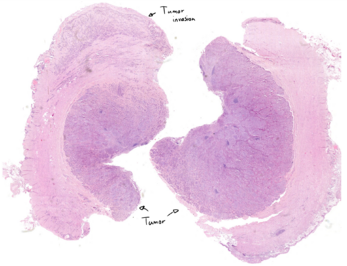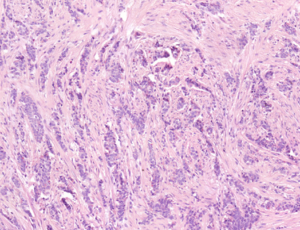5. Carcinoid or NET of the appendix: Difference between revisions
No edit summary |
No edit summary |
||
| Line 1: | Line 1: | ||
[[File:Carcinoid of the appendix - overview.png|thumb|Overview|347x347px]]'''Staining''': HE | [[File:Carcinoid of the appendix - overview.png|thumb|Overview|347x347px]]'''Staining''': HE . '''Organ''': Appendix | ||
'''Description''': | '''Description''': | ||
Revision as of 13:16, 7 July 2024

Staining: HE . Organ: Appendix
Description:
In the middle of the slide is the “main” tumor separated into two parts. This “main” tumor appears to have an expansile, well-demarcated border. However we can see that the tumor cells has infiltrated the upper left part of the slide, so the tumor is definitely malignant and not benign.
The tumor cells show an “insular” pattern, where they are arranged into “nests” of wildly varying size. They also show a mild atypia (pleiomorphism), and they have salt and pepper chromatin. Nuclear moulding is visible as well.

Diagnosis: Carcinoid/low grade neuroendocrine tumor of the appendix
Risk factors: Genetic
Theory:
The term “carcinoid” refers to a neuroendocrine cancer. In the GI tract is not the term “carcinoid” preferred but rather the term “low grade neuroendocrine tumor”. The histological morphology of the tumor cells is similar to that of the neuroendocrine tumor in the pulmonology chapter. The cells are small, they have the salt and pepper chromatin morphology and show only mild atypia.

Neuroendocrine tumors are always malignant. The fact that the “main” tumor in the slide shows benign features like its well-circumscribed, expansile border must not mislead you. The tumor has already invaded to the upper left corner of the slide. Compare that corner with the right side of the slide, which is cancer-free.

